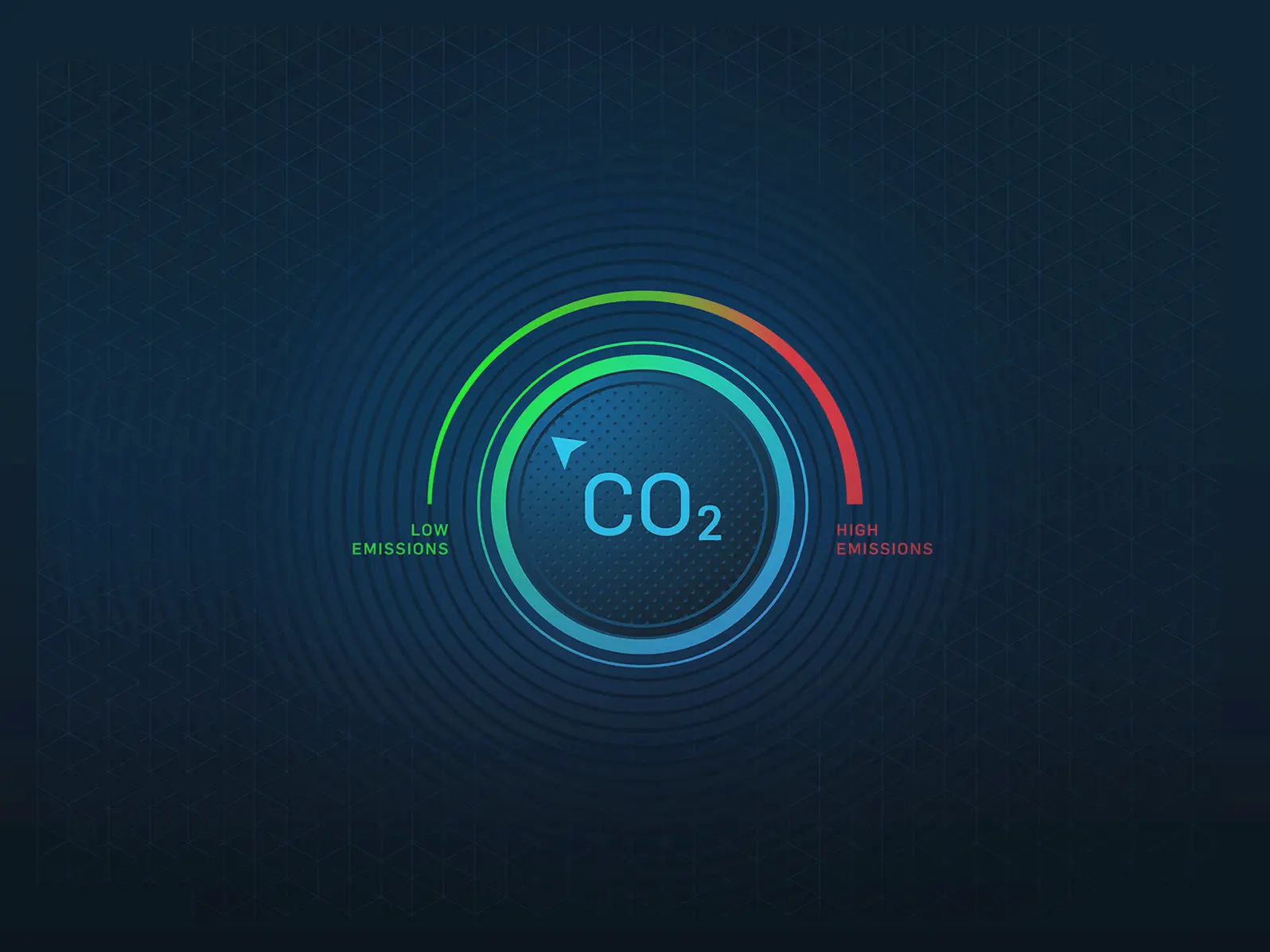Six theories on climate neutrality in the European transport sector
A summary paper comprises the key findings from a study commissioned by FVV and conducted by Frontier Economics and ifeu and specifies the resultant needs for action. As in every study that uses models to predict future developments, the results are dependent on the boundary conditions that were set at the beginning. The assumptions upon which this study is based do not follow a single political ideal, but are based on scientific facts and the non-partisan Sustainable Development Goals set out by the United Nations.
42 possible transformation paths
The FVV study combined the following paths – solely based on sustainable solar and wind energy – and assumed 100 per cent fleet penetration* by 2050:
7 combinations of powertrains and CO2-neutral energy carriers
- Battery electric powertrain | electricity
- Fuel cell | hydrogen
- Combustion engine | hydrogen
- Combustion engine | dimethyl ether (DME)
- Combustion engine | methane
- Combustion engine | Fischer-Tropsch fuel
- Combustion engine | methanol
2 ways to generate electricity or fuels
- Within the European Union (EU27 and the UK)
- Internationally at sunny/windy locations
3 efficiency classes in vehicle technology
- Status quo: current level of series production or estimate of scale effects
- Balanced: use of additional technologies with a positive cost-benefit ratio, e.g. hybridisation of combustion engines
- All-in: use of all known technologies to increase efficiency, e.g. lightweight chassis construction
*The study consciously works with theoretical 100 per cent scenarios, albeit hardly realistic or desirable, as these enable an excellent comparison of the technical and economic impact of individual technology paths.
- The 17 Sustainable Development Goals set out by the United Nations* must be achievable around the globe and for all people. As combustion engines to date have primarily been powered with fossil fuels, particular importance is placed on the 13th goal: taking urgent action to combat climate change and its impacts. However, other Sustainable Development Goals (SDGs) must also be taken into account, particularly affordable and clean energy, decent work and economic growth, industry, innovation and infrastructure, sustainable consumption and production and global partnerships.
- There are no ›good‹ or ›bad‹ technologies. The benchmark set out by FVV for technologies to defossilise the transport sector is solely the degree to which they can contribute to reaching the goals of the Paris Agreement without coming into conflict with other SDGs. In this regard, technology neutrality does not mean keeping all options open and not making any decisions, but assessing various existing options based on their climate effectiveness and the associated economic costs.
- The goals of the Paris Agreement must be achieved. Simply eyeing a period x after which no more greenhouse gases are released into the atmosphere is not conducive to reaching the goals. As CO2 remains in the atmosphere for a long period of time, the decisive factor in achieving the climate targets (›well below 2°C‹) is the degree to which the various transformation paths on the journey to this goal impact the remaining global CO2 budget – regardless of which sector the emissions are generated in.
- Germany will only meet its goals as part of Europe. Solely observing the balance in Germany is not a sensible approach given the close political and economic links within Europe, as well as the increasing amount of cross-border transport. The FVV study therefore calculates the development of greenhouse gas emissions from the entire European transport sector (EU27 and the UK) in various scenarios.
- There is still strong demand for individual mobility. Individual mobility is a fundamental right of all citizens in a democratic and free society. Changes to mobility behaviour or the selection of certain technologies will only be successfully established if they benefit the people. We assume that individual mobility must be designed to be both sustainable and affordable.
A life-cycle assessment (LCA) takes into account all environmental impacts during the product life cycle. These include in particular production, including materials and components, the service life, disposal and recycling. If the assessment is restricted to a specific phase of the life cycle, such as the service life of a vehicle, it is possible that technologies which do not lead to emission savings in the overall assessment may also have a good balance sheet. Therefore, there is no way around a comprehensive analysis that covers all emissions over the entire life cycle of a technology.
Besides
- the operation of a vehicle (Tank-to-Wheel)
this includes in particular
- the manufacture of the vehicle (cradle-to-gate)
- the generation and supply of the drive energy (well-to-tank)
- the construction and operation of the necessary transport networks (roads, railways and waterways) and supply and disposal facilities (infrastructure)
- the vehicle’s recycling to recover raw materials (end-of-life).
The global CO2 budget of the Intergovernmental Panel on Climate Change (IPCC), also known as carbon budget or emissions budget, refers to the amount of CO2 emissions from anthropogenic sources that have been released or can still be released since the beginning of industrialisation in order to avoid global warming beyond a defined limit with a certain probability.
The global CO2 budget in the sense of a residual amount of remaining emissions that can still be emitted into the atmosphere comprises the cumulative total of all greenhouse gases emitted worldwide. For effective climate protection, the cumulative amount of greenhouse gases emitted must be limited. To achieve this, the entire energy industry must be completely decarbonised (closed carbon cycle with net zero emissions). The decisive factor for the extent of climate change is therefore not the current emission of greenhouse gases, as is often wrongly assumed, but the total amount of emissions that will occur over time.
On the basis of the Paris Climate Protection Agreement, Germany and the European Union have set themselves the ambitious goal of reducing greenhouse gas emissions (CO2-eq, CO2) by 80-95 % by 2050 compared to 1990. Accordingly, the German government's Climate Protection Plan 2050 includes an interim target for 2030. By then, CO2 emissions should be at least 55% below the 1990 level. This target has been broken down into individual targets for the energy, buildings, transport, industry, agriculture, forestry and land use sectors.
CONCLUSION:
- All measures taken to reduce CO2 emissions in the individual sectors must be based on how effective they are in making efficient use of the CO2 residual budget.
- In order to be able to evaluate technologies meaningfully with regard to climate and sustainability aspects, all direct and indirect effects from all upstream and downstream stages of the value chain must be taken into account.
- For a sustainable technology selection a comprehensive cross-sectoral, global and intertemporal life cycle analysis is required.
-
Climate neutrality assessments in the transport sector must include the entire vehicle life cycle and the provision of energy.
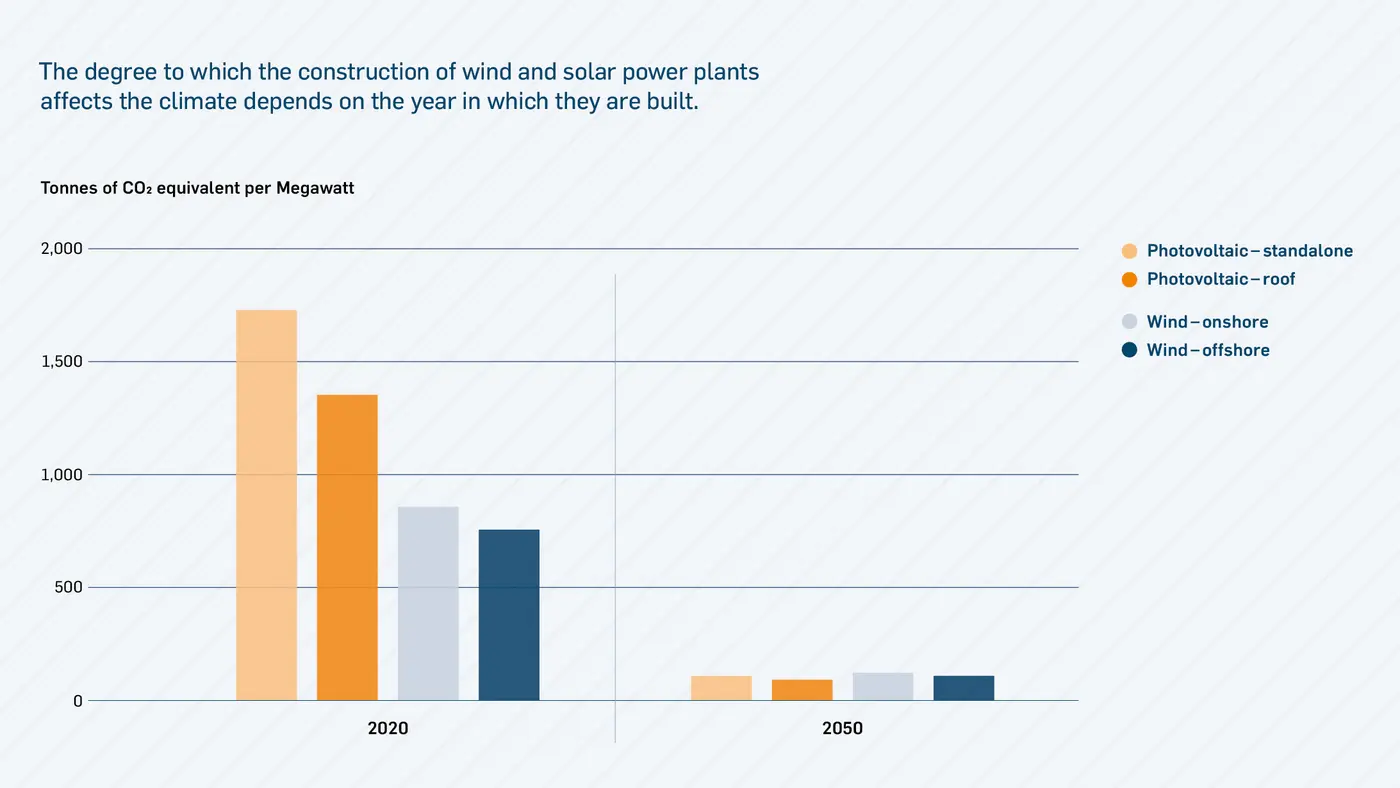
Detailed results can be found in the FVV Fuel Study IV ›Transformation of mobility to the GHG-neutral post-fossil age‹ (H1269 | 2021 | EN):
→ p. 35 – 66
Modelling of energy supply chains→ p. 76 – 83
Environmental impact analysis | Build-up of fuel supply chain infrastructureTo date, the impact of vehicles on the climate was solely determined on the basis of CO2 emissions output by the vehicle’s exhaust system while in operation. However, this approach, dubbed ›tank-to-wheel‹ by experts, does not go far enough. Not only does it fail to consider the CO2 emissions generated during vehicle production, it ignores all other greenhouse gases resulting from the generation and provision of the energy carriers and their storage, as well as the associated infrastructure. Effective climate protection requires all these emission sources to be taken into account in a holistic environment footprint, known as a ›cradle-to-grave‹ approach. Limiting emissions solely to a tank-to-wheel analysis – as is currently specified – can result in increased cumulative greenhouse gas emissions overall.
In the majority of existing studies, the greenhouse gas emissions resulting from the generation and provision of the energy carriers were amortised over the duration of their use. This conventional approach to balancing not only precludes an objective comparison, but also prevents the optimisation of the energy chain in its entirety. In reality, the remaining CO2 budget is impacted immediately at the time when the plants are constructed – and not 20 years later. It is of paramount importance that climate-relevant emissions generated due to mobility demands are balanced completely.
-
Powertrain technologies are not the decisive factor in achieving the climate goals, but rather the fastest possible departure from fossil energy carriers.
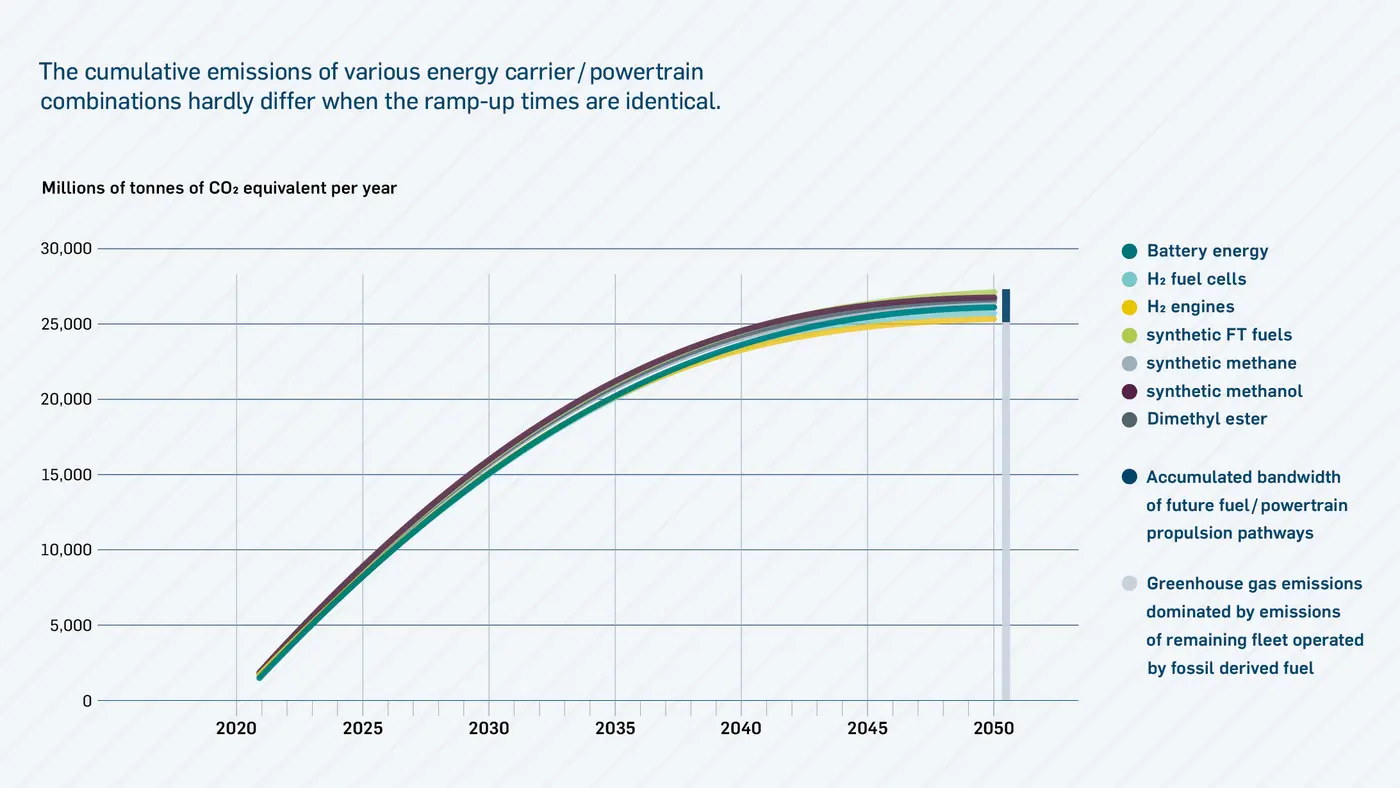
Detailed results can be found in the FVV Fuel Study IV ›Transformation of mobility to the GHG-neutral post-fossil age‹ (H1269 | 2021 | EN):
→ p. 35 – 39
General assumptions for all fuel supply chains | Hydrogen production and storage→ p. 96 – 103
Environmental impact analysis | GHG emissions in the 100 % scenariosThe FVV study analyses a total of 21 combinations of powertrains, energy carriers and efficiency technologies in vehicles. For each combination, a scenario was created in which wind and solar energy was generated entirely within Europe, and a scenario where the energy was generated outside Europe, resulting in a total of 42 scenarios. If we include all emissions from the development of the energy infrastructure and the entire life cycle of the vehicle, the cumulative CO2 emissions of the calculated transformation paths only differ slightly up to 2050, provided that only emission-free vehicles can be registered as of 2033. The difference between the observed paths is around 14 per cent and, in light of the remaining uncertainties in the forecast, does not represent a decisive criterion for a certain technology.
In other words: it is not the powertrain technology, but the availability of climateneutral energy carriers that will decide just how quickly and comprehensively the fleet of existing and new vehicles is actually climate-neutral. In addition to sufficient capacities for generating solar and wind energy, the quick establishment of a green hydrogen economy is of crucial importance in all scenarios. This also explicitly applies to the hypothetical scenario of a complete transition to battery electric vehicles powered by electricity generated in Europe. In order to always meet the electricity demands in such a scenario without falling back on fossil energy carriers, hydrogen buffer storage providing energy during cold, dark periods with low wind – based on an electrolysis capacity of around 1,000 gigawatts in total – will be required.
-
The carbon footprint of the existing fleet is decisive when it comes to adhering to the climate budget.
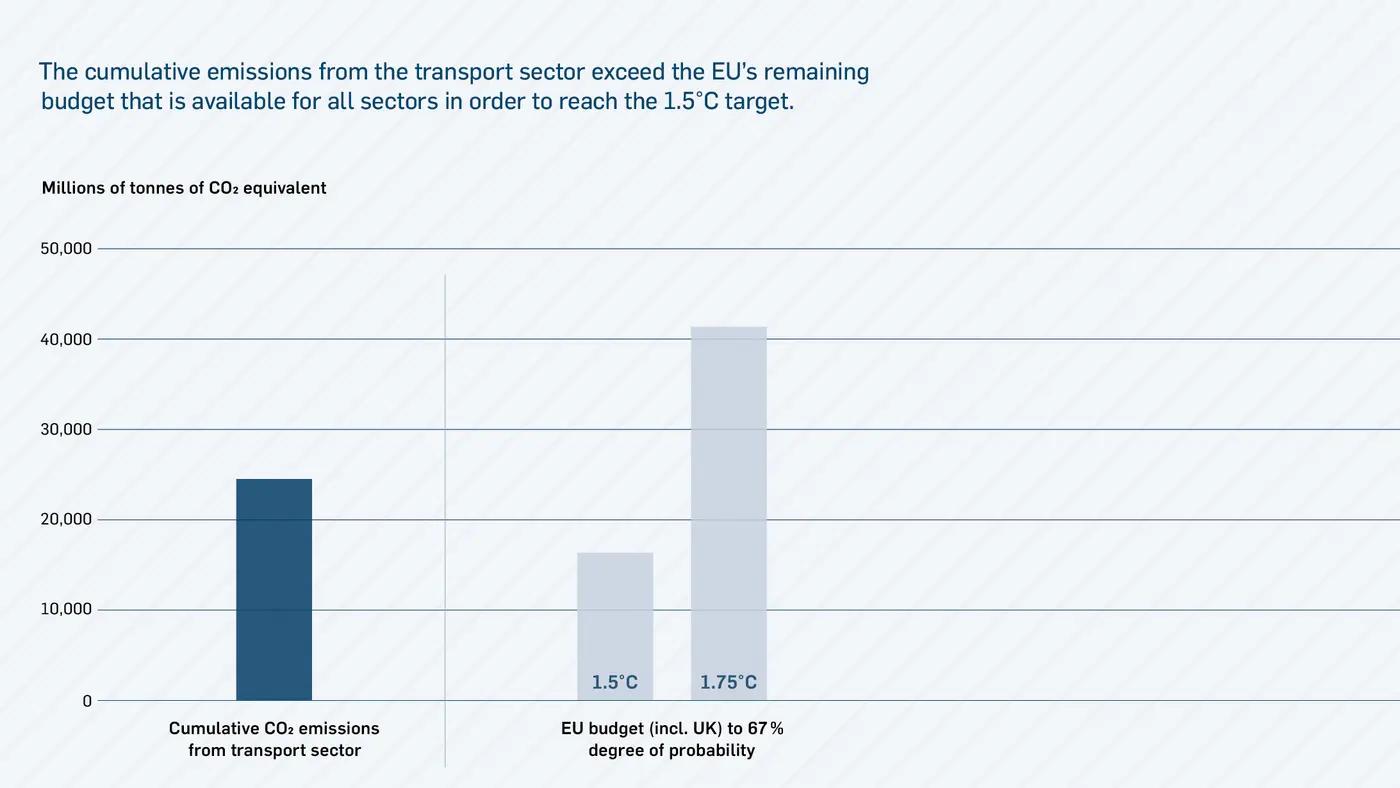
Detailed results can be found in the FVV Fuel Study IV ›Transformation of mobility to the GHG-neutral post-fossil age‹ (H1269 | 2021 | EN):
→ p. 103 – 105
Environmental impact analysis | Comparison of cumulative GHG emissions with the remaining CO2 budget→ p. 157 – 158
Key findings and conclusions | GHG emissionsIf it is necessary to introduce new vehicle technologies in order to enable climate-neutral mobility, the conversion to sustainable energy carriers is inevitably linked to the fleet turnover rate. As cars are kept for an average duration of 17 years, from 2033 only emission-free cars and small commercial vehicles can be registered if the goal is for road traffic to be completely based on sustainable energy sources in 2050. If the share of newly registered cars reaches 100 per cent by 2033 and every single new vehicle is powered solely using renewable energy during the ramp-up phase – which is far from the case today – a 28 per cent share of fossil energy in the transport sector can be replaced by the year 2030 without negatively affecting other sectors.
However, even if the ambitious goals outlined in the FVV study are met, the existing fleet powered by fossil fuels still makes up a dominant share of cumulative CO2 emissions. Regardless of the powertrain technologies used in the new, climate-neutral vehicles, these emissions make up around 70 per cent of the total mobility-related emissions based on the assumed ramp-up duration. This would result in Europe’s entire greenhouse gas budget, which would enable adherence to the 1.5°C target*, being exceeded as early as 2031 or 2032 – regardless of the scenario model. Our mobility needs alone will account for two thirds of the greenhouse gas budget available to all sectors in Europe in order to limit the temperature increase to 1.75°C – and this is before heating a single house, or manufacturing any other industrial product outside the mobility sector. To prevent this from happening, the mobility sector must stop using fossil energy sources sooner than the vehicle fleet can be replaced with vehicles using new powertrain technologies.
It is therefore an absolute necessity to find solutions that reduce harmful emissions from existing vehicles. According to the current state of the art, and to avoid any appreciable impact on mobility, this will largely only be possible through the use of compatible synthetic fuels (known as drop-in fuels).
* Due to the imprecision of the climate models upon which they are based, the emissions budgets are probable estimates for which a certain average global temperature increase will occur. A probability of 67 per cent is given for the specifications above.
-
Concentrating on a single technology will result in a lack of resources, even in a circular economy.
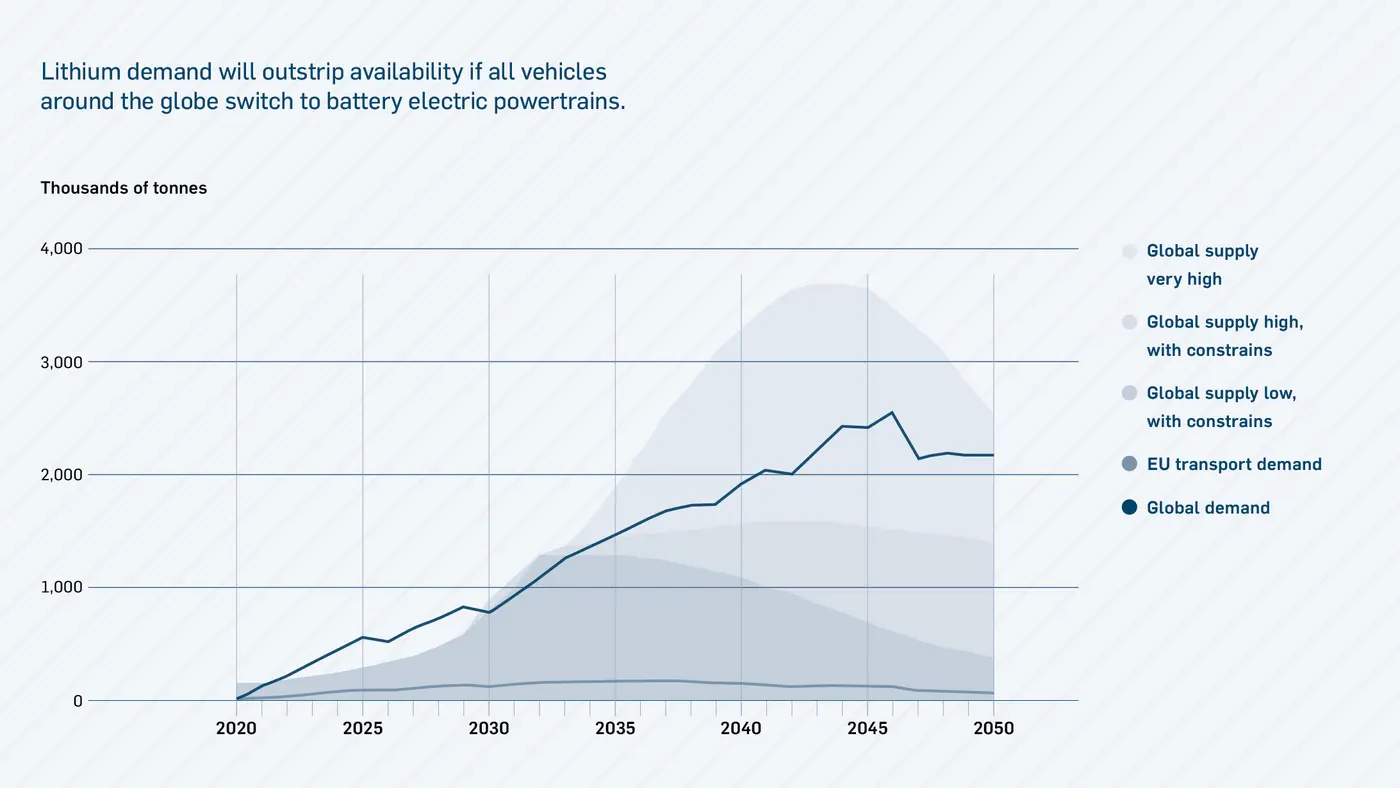
Detailed results can be found in the FVV Fuel Study IV ›Transformation of mobility to the GHG-neutral post-fossil age‹ (H1269 | 2021 | EN):
→ p. 113 – 140
Analysis of critical raw materials→ p. 159
Key findings and conclusions | Rare materialsThe FVV study consciously works with what are known as ›100 per cent scenarios‹, as these enable an excellent comparison of the environmental impact of individual technologies throughout the entire energy chain and the vehicle life cycle, while also allowing bottlenecks to be determined. Comparing the demand for critical raw materials with the available reserves and resources shows that – even assuming a high recycling rate – certain raw materials will become very scarce if the rest of the world follows the European model and uses the same technologies. The raw materials in question depend on the selected combination of energy carrier and powertrain.
For example, if the selected technology is battery electric vehicles using the currently dominant battery technology (lithium-ion batteries with nickelmanganese-cobalt cathodes), cobalt and lithium availability will be the limiting factor for the ramp-up speed, and this will have a significant impact on the cost of the batteries. Moving to solid-state batteries with a pure lithium anode will significantly exacerbate the scarcity of resources in the lithium supply chain. For fuel cell powertrains, the availability of platinum is a highly limiting factor. In a scenario in which the entire world transitions to 100 per cent fuel cell use, all known resources will not be sufficient, let alone those that can be tapped in an economically viable manner. No such bottlenecks are currently known when it comes to the use of hydrogen or synthetic fuels in combustion engines.
-
Enough energy can be produced to defossilise the entire mobility sector.
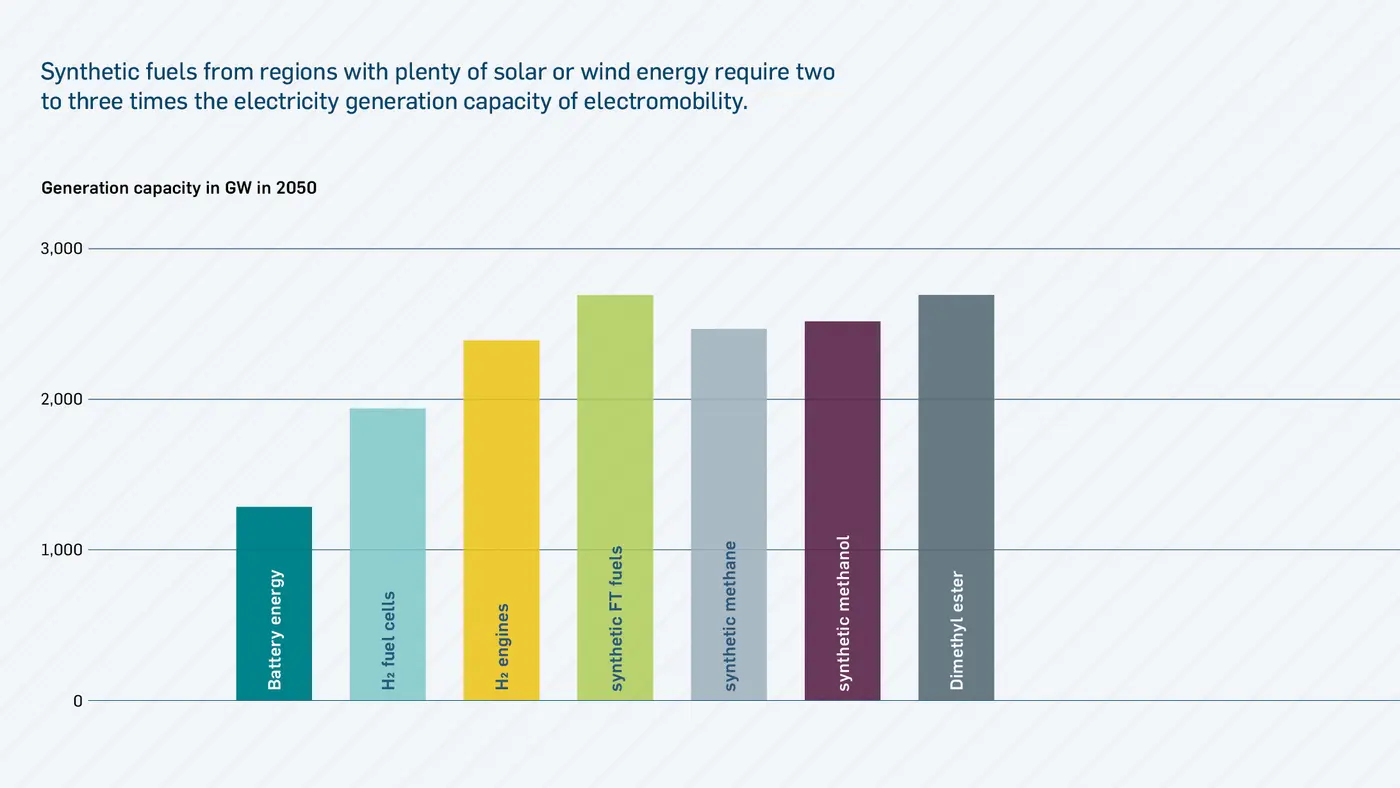
Detailed results can be found in the FVV Fuel Study IV ›Transformation of mobility to the GHG-neutral post-fossil age‹ (H1269 | 2021 | EN):
→ p. 71 – 72
Comparison of energy supply chains for road segment | Capacity requirements in 2050→ p. 160
Key findings and conclusions | Installed power generation capacityThe global potential of sustainable solar and wind energy exceeds the entire primary energy demands of humanity in its entirety several times over. This energy must only be harvested, prepared and distributed using methods that enable technical usage, particularly in the transport sector. This also applies to all mobility transition paths observed in the study – however, the total energy demands for individual energy chains differ significantly. A 100 per cent transition to synthetic fuels used in combustion engines would triple or quadruple energy demands compared to pure battery electric mobility. However, this does not mean that up to four times as many wind energy power plants need to be built. If these fuels were to be produced in regions with plenty of wind and solar energy, the capacity required to generate green electricity would only differ by a factor of two to three.
The additional economic costs to produce energy for climate-neutral mobility are not determined by the amount of energy, but by the capacities required. The increased costs are, however, overcompensated for by the higher vehicle costs associated with battery electric mobility. All things considered, the total costs for an internal combustion engine vehicle powered by synthetic fuels are significantly lower than those for a battery electric vehicle.
All scenarios require a significant expansion of green electricity production. Even the most energy-efficient scenario – the transition to 100 per cent battery electric mobility – will require Europe to generate 1,100 gigawatts of energy in 2050 to cover all of its mobility demands. To compare: according to the International Renewable Energy Agency, the capacity for solar and wind generation in Europe for all sectors will increase to just 690 gigawatts by 2030.
-
In order to meet the goals of the Paris Agreement, multiple technology paths must be pursued immediately.
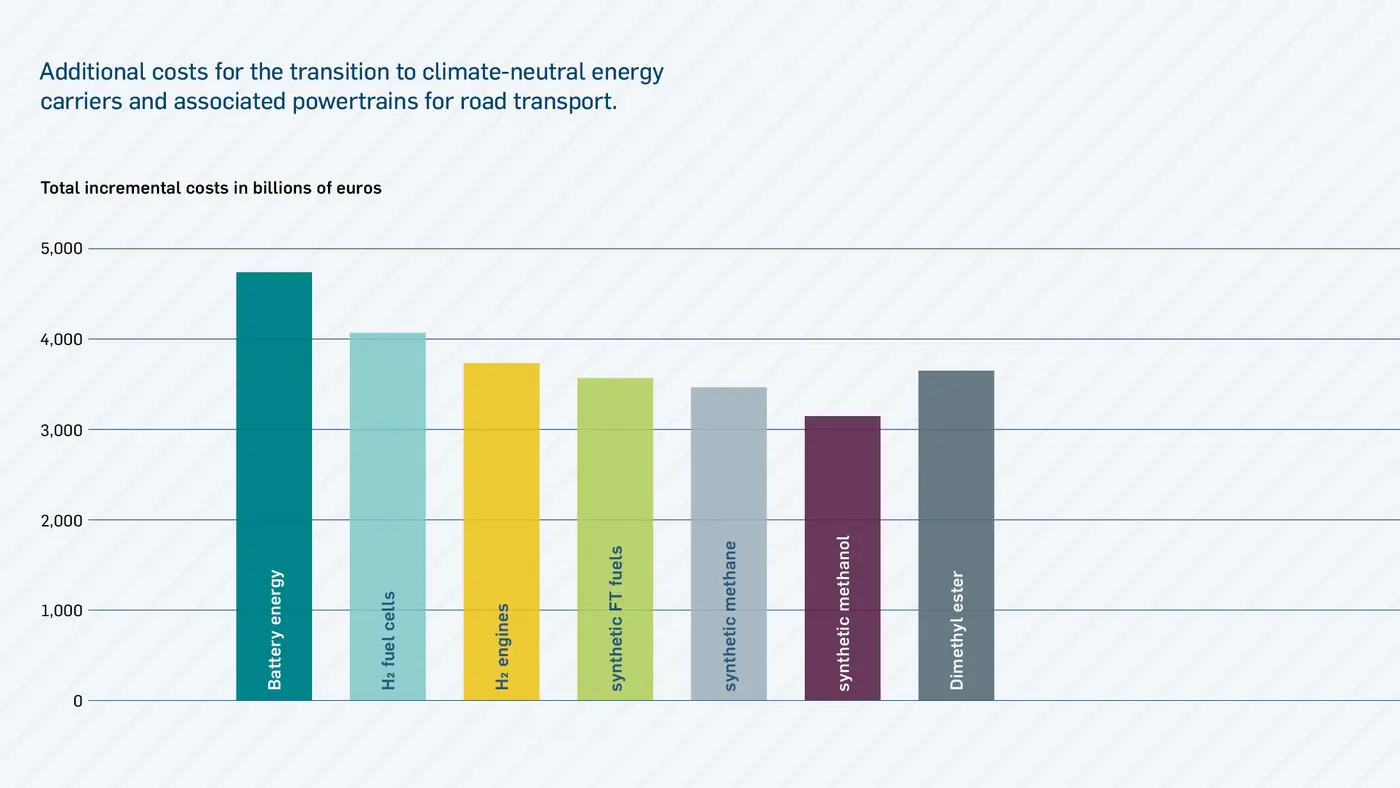
Detailed results can be found in the FVV Fuel Study IV ›Transformation of mobility to the GHG-neutral post-fossil age‹ (H1269 | 2021 | EN):
→ p. 141 – 155
Cost estimations→ p. 160
Key findings and conclusions | CostsIf European politics continues to ignore the existing vehicle fleet and only measures the climate compatibility of new vehicles based on tank-to-wheel emissions, the transformation in the transport sector will be doomed to fail. New goals must be defined if we hope to quickly reduce the CO2 emissions generated by mobility needs. Within the scope of a cradle-to-grave observation, these goals should consider the emissions generated when expanding the energy infrastructure and thus also extend beyond a well-to-wheel approach. European politics must create a market economy framework for the transport sector which then enables multiple technology paths to be established simultaneously. If multiple paths are pursued with the objective of withdrawing from the use of fossil energy carriers, the ramp-up speed will probably also be quicker.
This approach not only benefits climate protection, but also minimises the total economic costs which are dominated by vehicle costs. Cost comparisons that do not include the vehicle costs must therefore be viewed critically. A technology-neutral approach will also ensure that individual mobility remains affordable for a wide section of the population.
Are we having the wrong debate?
Is it the choice of future technology or the existing vehicle fleet that determines whether climate targets are met? Since the pace at which we can ramp up new technologies is what determines how much CO2 from the transport sector makes its way into the atmosphere, a complementary study will take a close look at this question. Secondly, technologies can be combined. In this context, it is important that we consider technology options that will also reduce emissions in vehicles that are already on the roads. There are many arguments in favour of a technological mix, for example of electromobility supplied with electricity generated in Europe and internal combustion engines powered by synthetic fuels that have been efficiently produced in the sunny and windy regions of the world. Finally, the raw material bottlenecks identified in the present study can have a decisive influence on the progression of effective and cost-efficient pathways to achieve sustainable climate-neutral mobility, even in a circular economy. Therefore, we want to look at this in more detail in the aforementioned follow-up study.
Further information
DETAILED RESULTS
- FVV Fuels Study IV: ›Six theories on climate neutrality in the European transport sector‹ (R600 | 2021 | EN)
- FVV Fuels Study IV: ›Transformation of mobility to the GHG-neutral post-fossil age‹ (H1269 | 2021 | EN)
THE RESULTS IN BRIEF
- Video presentation 25.04.2022 (0:20 | EN)
- Video presentation 25.04.2022 (0:20 | DE)
- Video presentation 30.12.2021 (1:07 | EN)
- Video presentation 01.10.2021 (1:51 | DE)
- Presentation slides 30.12.2021 (EN)
- Presentation slides 25.04.2022 (EN)
LINKS
- How quickly can we be sustainable? | FVV gives insights into sustainable pathways to climate-neutral mobility
- Taking stock | New FVV meta-analysis of LCA Studies on Alternative Powertrain Technologies
- What if...? | Options for climate-neutral mobility in 2050
- Further studies of the FVV
